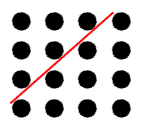Everyone knows what squares are. The product of a number \(n\) with itself is a square, so called because you can make an \(n \times n\) array from \(n^2\) objects. Few people, however, know about triangle numbers. Triangle numbers result from arranging objects to form a triangle.

Thus,
$$ \begin {eqnarray} T_1 &=& 1 \\ T_2 &=& 3 \\ T_3 &=& 6 \\ T_4 &=& 10 \\ &\vdots& \end {eqnarray} $$It should also be apparent that each \(T_n\) is the sum of the first \(n\) whole numbers. So,
$$ T_n = 1 + 2 + 3 + \dots + n $$Now suppose \(n\) is even. Then we can rearrange the terms of the sum by pairing the first term with the last, second term with the second last, and so on to get,
$$ n + 1 + [(n - 1) + 2] + [(n - 2) + 3] + \dots + [(\frac n 2 + 1) + \frac n 2 ] $$The result is \(\frac n 2\) terms all equal to \((n + 1)\). Thus,
$$ T_{n_{even}} = {n(n + 1) \over 2} $$This result can also be proved by mathematical induction. Similarly, if \(n\) is odd, we get \((n - 1) \over 2\) terms all equal to \((n + 1)\) plus an additional term, \((n + 1) \over 2\). This also reduces to,
$$ T_{n_{odd}} = {n(n + 1) \over 2} $$Triangle numbers have a number of interesting properties. For example, the sum of two adjacent triangle numbers is always a perfect square. You can easily see this from the illustration.

You
can also prove it by considering:
Note that if you sum the two sequences for \(T_{n - 1}\) and \(T_{n}\), you get a sum of a sequence of odd numbers. This shows that square numbers can be expressed as a sum of a sequence of odd numbers.
$$ \begin {align} T_{n} &= &1 + &2 + 3 + 4 + \dots + n \\ T_{n - 1} &= & &1 + 2 + 3 + \dots + (n - 1) \\ T_{n} + T_{n - 1} &= &1 + &3 + 5 + 7 + \dots + (2n - 1) \\ n^2 &= &1 + &3 + 5 + 7 + \dots + (2n - 1) \end {align} $$